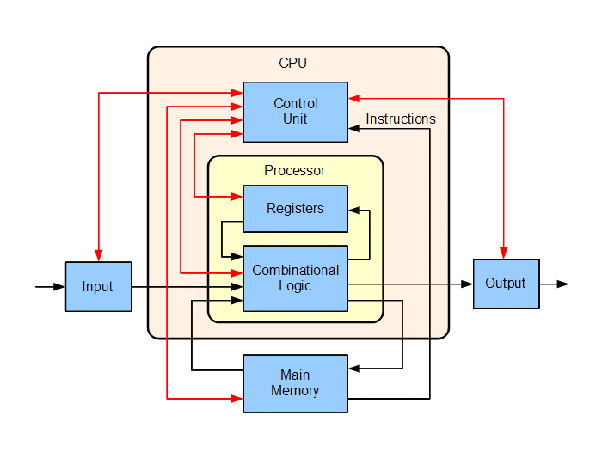A CPU core is a processing unit within a CPU that handles tasks and instructions. Modern CPUs often have multiple cores, allowing for better multitasking and improved performance in demanding applications. Each core can execute its own instructions simultaneously, improving overall system efficiency and speed. The more cores a CPU has, the better it can handle multiple tasks at once, leading to faster performance.
“A CPU core is a single processing unit within a central processing unit (CPU) that executes instructions. Modern CPUs often have multiple cores, allowing them to perform parallel processing and improve overall performance.”
In this article, We will discuss “ What Is Core Cpu”.
Table of Contents
How Does a CPU Core Function?

A CPU core works by carrying out the fundamental tasks of a computer: fetching instructions, decoding them, executing them, and then storing the results. It does this at incredibly fast speeds, processing billions of instructions per second, depending on the clock speed of the CPU. Each core is like an individual worker, processing a task independently from others, and modern CPUs can have many cores, allowing them to handle several tasks at once.
Key Tasks of a CPU Core:
- Fetching Instructions: This is the process of retrieving data from the system’s memory or cache, which contains the instructions that need to be processed. The instructions are then passed to the decoder in the core.
- Decoding Instructions: Once the instruction is fetched, the core decodes it into a format that can be understood by the CPU, transforming high-level commands into low-level operations that the CPU can execute.
- Executing Instructions: After decoding, the core performs the necessary calculations or operations. This could involve mathematical computations, logic operations, or moving data between registers or memory.
- Storing Results: After executing the task, the core stores the results back into the system’s memory or caches, making them available for use in the next instruction or task.
Single-Core vs. Multi-Core CPUs:
When single-core CPUs were common, the CPU could only process one task at a time, meaning multitasking was handled by rapidly switching between processes. However, this limitation slowed down computers, especially as software became more complex and demanded more resources.
Multi-core CPUs address this limitation by incorporating multiple cores in a single processor. For example, a quad-core CPU has four independent cores, and an octa-core CPU has eight. With more cores, a CPU can perform multiple tasks in parallel, significantly improving multitasking, the ability to run multiple applications, and the handling of demanding processes.
Also Read: How To Undervolt CPU Gigabyte Bios – Tips For Enhanced Stability And Efficiency!
Single-Core CPUs:
A single-core CPU can only execute one task at a time. In the past, single-core processors were sufficient for everyday computing tasks like word processing or browsing. However, they became inefficient as applications grew more complex and required more computational power.
Multi-Core CPUs:
Dual-core CPUs feature two processing units, allowing for basic multitasking and faster performance in certain applications. Quad-core CPUs, with four cores, offer better performance for users who run more demanding applications or multitask extensively.
CPUs with six, eight, or more cores are designed for heavy-duty tasks such as video editing, gaming, and running complex simulations. The more cores a CPU has, the better it is at handling multiple processes simultaneously.
How Do Multiple Cores Improve Performance?

More cores allow the CPU to handle several threads (independent tasks or processes) simultaneously. This is particularly useful for software that supports multi-threading, where a program is split into smaller tasks that can run concurrently.
For example, video editing software like Adobe Premiere Pro or 3D rendering programs like Blender can divide their workload into smaller tasks, assigning them to different cores. With more cores, these programs can complete tasks faster because the workload is distributed.
Similarly, in gaming, many modern titles are optimized for multi-core processing, allowing the CPU to handle different aspects of the game—like AI, physics, and graphics rendering—across different cores. This reduces the overall load on any single core, leading to smoother and more responsive gaming experiences.
Benefits of Multi-Core Processors:
- Better Multitasking: Multi-core processors make it easier to run multiple applications simultaneously without experiencing lag or slowdowns. If you’re working with several applications open (e.g., a web browser, word processor, and music player), a multi-core CPU can handle all these tasks more efficiently.
- Improved Performance in Multi-Threaded Applications: Programs like video editors, 3D modeling software, and scientific simulation tools can make use of multiple cores to divide their tasks, improving processing speed and efficiency.
- Efficient Power Usage: Multi-core CPUs can be more energy-efficient than older, single-core models. When performing lightweight tasks, the CPU can run with fewer cores activated, saving power. Conversely, when running more intensive tasks, the CPU can activate more cores to handle the increased workload.
- Enhanced Gaming Performance: Modern games use multi-core CPUs to distribute the load of processing different elements like graphics, physics, and AI. This means that having more cores can improve gaming performance, especially in CPU-intensive titles.
Understanding CPU Clock Speed and Cores:
While having multiple cores can improve performance, clock speed (measured in GHz) also plays a critical role. Clock speed determines how many cycles per second a CPU can execute, and it impacts how quickly a single core can process instructions.
While more cores allow for better multitasking and parallel processing, a higher clock speed increases the efficiency of single-threaded tasks. That’s why balancing the number of cores with the clock speed is crucial when selecting a CPU, especially for tasks that rely on single-threaded performance, like gaming or web browsing.
Also Read: Best Ryzen CPU – Top Picks For Performance and Value!
Hyper-Threading Technology:
Intel’s Hyper-Threading Technology allows each physical core to act as two logical cores. This means that, even though there are fewer physical cores, the processor can handle twice the number of tasks by simulating two threads per core. Hyper-Threading can improve performance in multi-threaded applications, but it’s not as powerful as having additional physical cores.
How Many Cores Do You Need?
The number of cores you need depends on how you use your computer. For basic tasks like browsing the web, word processing, and light multitasking, a dual-core CPU is often sufficient. However, for more demanding tasks like gaming, video editing, 3D rendering, and running virtual machines, a quad-core or higher processor is preferable. High-end users who work with data-heavy applications or need to run multiple programs simultaneously may benefit from 8-core or 12-core processors.
FAQ’s
1. What is a CPU core?
A CPU core is a processing unit within a CPU that executes instructions and performs tasks in a computer.
2. How many cores does a CPU need?
The number of cores depends on the tasks you perform; for basic tasks, two cores may be sufficient, but for gaming or professional applications, four or more cores are recommended.
3. Do more CPU cores improve performance?
Yes, more cores allow a CPU to handle more tasks simultaneously, improving performance in multitasking and multi-threaded applications.
4. Can a single-core CPU handle modern applications?
Single-core CPUs can run modern applications but may struggle with multitasking or demanding tasks like gaming or video editing.
5. What is the difference between physical and logical CPU cores?
Physical cores are actual, separate processing units, while logical cores (like Intel’s ahyper-Threading) simulate additional cores within the physical cores to improve performance.
Conclusion
In conclusion, a CPU core is a vital processing unit responsible for executing tasks in a computer. The number of cores in a CPU plays a significant role in multitasking and handling demanding applications. More cores allow for better performance and efficiency, especially in tasks such as gaming, video editing, and professional software usage.

